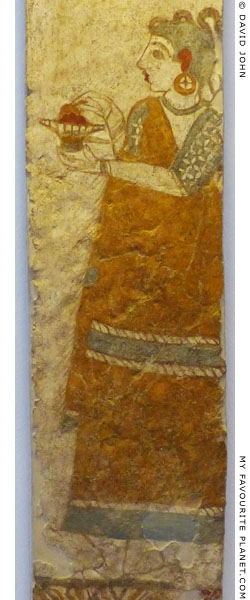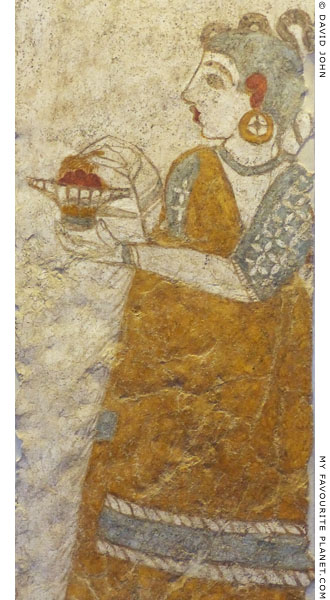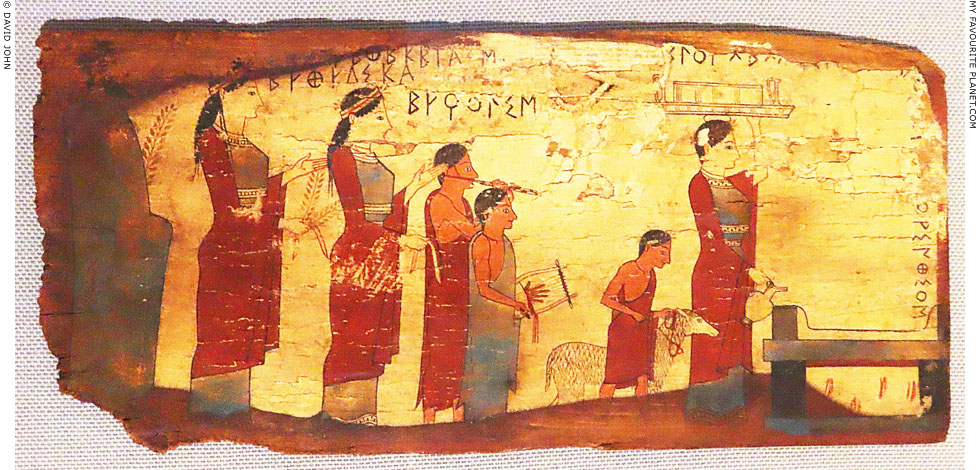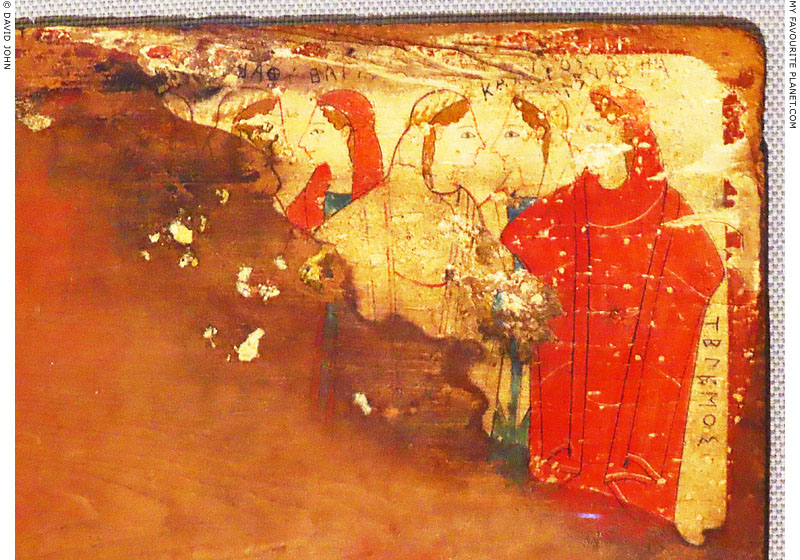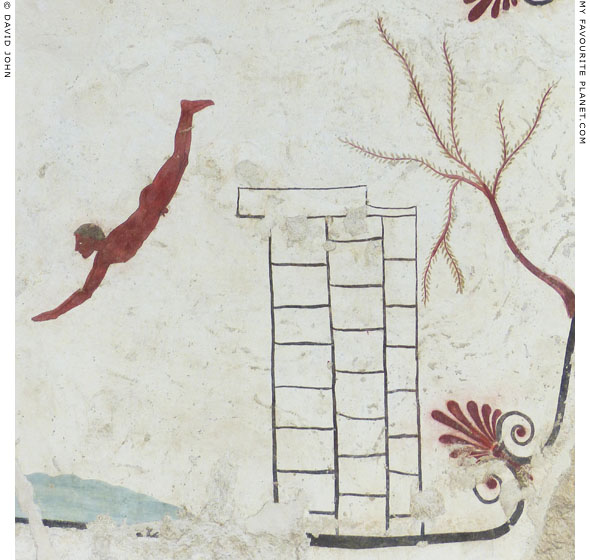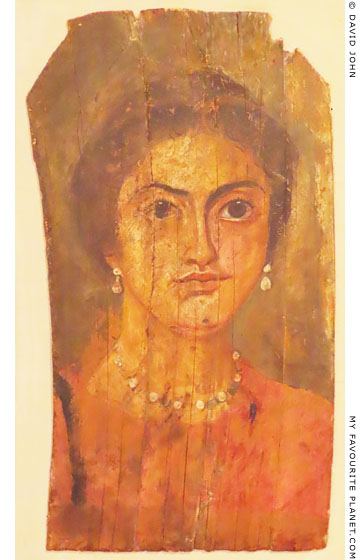|
|
|
| My Favourite Planet > English >
People > Ancient Greek artists> Painters |
| MFP People |
Ancient Greek artists – page 11 |
 |
Page 11 of 14 |
 |
|
| |
| Painters |
| |
As with sculpture (see Polykleitos), Roman period critics such as Cicero (Marcus Tullius Cicero, 106-43 BC) and Quintilian (Marcus Fabius Quintilianus, circa 35-100 AD) saw an evolution in technique and aesthetic quality in Greek painting, reaching its most advanced state in the works of Apelles and other painters from the time of Alexander the Great.
"The case is the same in painting; for in the works of Zeuxis, Polygnotus, Timanthes, and several other masters who confined themselves to the use of four colours, we commend the air and the symmetry of their figures; but in Aetion, Nicomachus, Protogenes, and Apelles, every thing is finished to perfection."
Cicero, Brutus, a History of Famous Orators, section 70. At attalus.org.
"The first great painters, whose works deserve inspection for something more than their mere antiquity, are said to have been Polygnotus and Aglaophon *, whose simple colouring has still such enthusiastic admirers that they prefer these almost primitive works, which may be regarded as the first foundations of the art that was to be, over the works of the greatest of their successors, their motive being, in my opinion, an ostentatious desire to seem persons of superior taste.
Later Zeuxis and Parrhasius contributed much to the progress of painting. These artists were separated by no great distance of time, since both flourished about the period of the Peloponnesian war: for example, Xenophon has preserved a conversation between Socrates and Parrhasius [Memoir. III. x. 1]. The first-mentioned seems to have discovered the method of representing light and shade, while the latter is said to have devoted special attention to the treatment of line.
For Zeuxis emphasised the limbs of the human body, thinking thereby to add dignity and grandeur to his style: it is generally supposed that in this he followed the example of Homer, who likes to represent even his female characters as being of heroic mould. Parrhasius, on the other hand, was so fine a draughtsman that he has been styled the law-giver of his art, on the ground that all other artists take his representations of gods and heroes as models, as though no other course were possible.
It was, however, from about the period of the reign of Philip down to that of the successors of Alexander that painting flourished more especially, although the different artists are distinguished for different excellences. Protogenes, for example, was renowned for accuracy, Pamphilus and Melanthius for soundness of taste, Antiphilus for facility, Theon of Samos for his depiction of imaginary scenes, known as φαντασίαι (phantasiai), and Apelles for genius and grace, in the latter of which qualities he took especial pride. Euphranor, on the other hand, was admired on the ground that, while he ranked with the most eminent masters of other arts, he at the same time achieved marvellous skill in the arts of sculpture and painting."
Quintilian, Institutio Oratoria, Book 12, chapter 10, sections 3-6. At Perseus Digital Library.
* Polygnotus of Thasos, son of Aglaophon, painted at Athens in the mid 5th century BC. Zunis of Heraclea and Parrhasius of Ephesus flourished 420-390 BC. The others were painters of the 4th century BC. Pamphilos of Sikyon was the teacher of Melanthius and Apelles. |
|
|
| |
Aetion
Αετίων
Painter and sculptor?
Mid 4th - early 3rd century BC |
A sculptor named Aetion is known from references by Pliny the Elder, Theocritus and Callimachus. Aetion as a painter was mentioned by Cicero, Pliny and Lucian, who described a painting of the Marriage of Alexander the Great and Roxana.
See the Aetion page for further details. |
|
|
| |
Apelles
Ἀπελλῆς
4th century BC
Probably born at Kolophon, Ionia, he was a pupil of Ephorus of Ephesus, and later of Pamphilos at Sikyon. He was a younger contemporary of Aristeides of Thebes.
Most of what is known about Apelles was written by Pliny the Elder (Natural History, Book 35), who also mentioned his friendship with the painter Protogenes. He is also mentioned by Plutarch (Parallel Lives, Alexander, chapter 4), Lucian, Pausanias, as well as Cicero and Quintilian (see quotes above).
Pliny tells us that Apelles was a fine draughtsman, particularly skilled in drawing faces. He travelled to the court of Philip II in Pella, Macedonia, where he painted Philip and his son, the young Alexander the Great, and was appointed as the court painter of Macedon.
Many of his paintings were later taken to Rome and exhibited publicly. None of his works have survived, but are said to have included:
Artemis surrounded by maidens offering a sacrifice, based on a passage from Homer's Odyssey.
Alexander holding a thunderbolt, sold to the Temple of Artemis at Ephesus for 20 talents of gold.
The procession of the Megabyzus, the high priest of Artemis at Ephesus.
A nude painting of Pancaste (also known as Pacate and Campaspe), the favourite concubine of Alexander, who may have been the model for his Aphrodite Anadyomene, although Athenaeus (The Deipnosophists, Book 13) wrote that the model was the courtesan Phryne.
Aphrodite Anadyomene (ἡ ἀναδυομένη Ἀφροδίτη, Aphrodite Rising from the Sea), a painting mentioned by several ancient authors. It was originally in the Asklepieion of Kos but was taken to Rome by Emperor Augustus, who placed it in the temple he dedicated to the deified Juilius Caesar in the Forum. The Koans (inhabitants of Kos) are said to have received a deduction of hundred talents from the tribute imposed by Rome in return for the painting (Strabo,Geography, Book 14, chapter 2, section 19).
In the same chapter Strabo wrote that there was also a portrait of Antigonus I Monophthalmus by Apelles in the Asklepieion of Kos (Strabo, Geography, Book 14, chapter 2, section 19), which may be the work mentioned by Pliny.
Equestrian portraits of Clitus the Black and Neoptolemos, generals of Alexander.
Portraits of King Archelaus of Macedon, one with his with his wife and daughter, another on horseback.
Sacrifice in Kos, described in the Mimes of Herodas (4.59).
The great allegory of Calumny.
Plutarch also mentioned Apelles' painting of Alexander holding a thunderbolt, as well as the comparison made by Lysippos to his statue of Alexander holding a spear.
"Apelles the painter and Lysippus the sculptor also lived in the time of Alexander. The former painted 'Alexander wielding the Thunderbolt' so vividly and with so natural an expression, that men said that, of the two Alexanders, Alexander, son of Philip, was invincible, but the Alexander of Apelles was inimitable."
Plutarch, On the fortune or virtue of Alexander, Oration II. In: Plutarch's Moralia, Volume 4 (of 15), 263D - 351B, pages 430-431, 335A. Loeb Classical Library edition, in Greek, with an English translation by Frank Cole Babbitt. Harvard University Press, Cambridge, Mass., and William Heinemann, London, 1962.
"Moreover, Lysippus the sculptor was quite right in his disapproval of the painter Apelles, because Apelles in his portrait of Alexander had represented him with a thunderbolt in his hand, whereas he himself had represented Alexander holding a spear, the glory of which no length of years could ever dim, since it was truthful and was his by right."
Plutarch, Isis and Osiris. In: Plutarch's Moralia, Volume 5 (of 15), 351C - 438E, pages 58-59, 360D. Loeb Classical Library edition, in Greek, with an English translation by Frank Cole Babbitt. Harvard University Press, Cambridge, Mass., and William Heinemann, London, 1936.
In the satirical novel Satyricon, the Roman author Petronius Petronius Arbiter (circa 27 - 66 AD) described the profound emotional effect of viewing the works of Protogenes and Appelles on his main character, the betrayed lover Encolpius:
"I came into a gallery hung with a wonderful collection of various pictures. I saw the works of Zeuxis not yet overcome by the defacement of time, and I studied with a certain terrified wonder the rough drawings of Protogenes, which rivalled the truth of Nature herself. But when I came to the work of Apelles the Greek which is called the One-legged, I positively worshipped it. For the outlines of his figures were defined with such subtle accuracy, that you would have declared that he had painted their souls as well. In one the eagle was carrying the Shepherd of Ida [Ganymede] on high to heaven, and in another fair Hylas resisted a tormenting Naiad. Apollo passed judgement on his accursed hands, and adorned his unstrung lyre with the newborn flower [Hyacinthus].
I cried out as if I were in a desert, among these faces of mere painted lovers, 'So even the gods feel love. Jupiter in his heavenly home could find no object for his passion, and came down on earth to sin, yet did no one any harm. The Nymph who ravished Hylas would have restrained her passion had she believed that Hercules would come to dispute her claim. Apollo recalled the ghost of a boy into a flower, and all the stories tell of love's embraces without a rival. But I have taken for my comrade a friend more cruel than Lycurgus himself.'"
Petronius, Satyricon, section 83. At Perseus Digital Library.
Pausanias noted a painting by Apelles of one of the Graces (Χάριτες, Charites) in the odeion of Smyrna (today Izmir):
"... and in the Music Hall [Odeion] in the same city there is a portrait of a Grace, painted by Apelles. At Pergamus likewise, in the chamber of Attalus, are other images of Graces made by Bupalus. And near what is called the Pythium there is a portrait of Graces, painted by Pythagoras the Parian."
Pausanias, Description of Greece, Book 9, chapter 35, section 6. |
|
|
| |
Aristeides of Thebes
Ἀριστείδης; Latin, Aristides Thebanus
Also known as Aristeides of Thebes II
Active second half of the 4th century BC
He was an older contemporary of Apelles.
He was posssibly the grandson or great grandson of Aristeides of Thebes I, and the son of the painter Nikomachos, who was also his teacher. He taught his sons Nikeros and Ariston.
"In addition to these [painters], it is only proper to mention Nicomachus, the son and disciple of Aristides. ... Among his pupils, were his brother Ariston, his son Aristides, and Philoxenus of Eretria."
Pliny the Elder, Natural history, Book 35, chapter 36. At Perseus Digital Library.
A confusing passage in Pliny the Elder's Natural History has been variously interpreted to mean that Antorides and Euphranor were pupils either of Aristeides of Thebes (Aristeides II) or Ariston, one of his sons. Other scholars believe that Euphranor's teacher was actually Aristeides' grandfather, Aristeides I. Likewise, it has been disputed which Aristeides was the pupil of Euxinidas (both references in Book 35, chapter 36).
See, for example: Katherine Jex-Blake and Eugenie Sellers, The elder Pliny's chapters on the history of art, page 117, note 75, and page 144, note 5. Macmillan & Co., London, 1896.
"... the first of all the painters to give full expression to the mind and passions of man, known to the Greeks as ἤθη, as well as to the mental perturbations which we experience: he was somewhat harsh, however, in his colours."
Pliny the Elder, Natural history, Book 35, chapter 36. At Perseus Digital Library.
Athenaeus of Naucratis, citing the treatise by Polemo (probably the geographer Polemo Periegetes, also cited by Strabo) on pictures at Sicyon, wrote that Aristeides, Pausanias and Nikophanes excelled in the portraits of courtesans and were nicknamed Pornographoi (πορνόγραφοι, pornographers).
Athenaeus, The Deipnosophists, Book 13, chapter 21. At Perseus Digital Library.
Aristeides painted a "Battle with the Persians", presumed to depict a battle between Alexander the Great and Darius III of Persia.
"Aristides also painted a Battle with the Persians, a picture which contained one hundred figures, for each of which he was paid at the rate of ten minae by Mnason, the tyrant of Elatea."
Natural history, Book 35, chapter 36.
This is one of three ancient paintings which some scholars believe may have been a model for the "Alexander Mosaic" (125-120 BC) found at Pompeii. The other two contenders are works by Helena of Egypt and Philoxenos of Eretria. However, since none of these paintings have survived, and information concerning their compositions is negligible, theories remain purely conjectural.
His painting of a dying woman with her child at her breast during the siege of a city was sent to Pella by Alexander the Great, presumably after he had sacked Thebes in 335 BC.
Natural history, Book 35, chapter 36. At Perseus Digital Library.
A number of other paintings by Aristeides mentioned by Pliny included a Father Liber (Dionysus) and Ariadne ("Liberum et Ariadnen") to be seen in the Temple of Ceres (see Demeter) at the Circus Maximus, Rome. (The translation at Perseus Digital Library gives "Artamene" for Ariadne, which is an error, and "two fine pictures".) Presumably a single picture of the two figures (see Dionysus for other depictions of the couple), it had been looted from Greece by the consul Lucius Mummius Achaicus, who sacked Corinth in 146 BC, and was "the first instance, I conceive, of a foreign painting being publicly exhibited at Rome". Attalus II of Pergamon had offered to pay 6,000 denarii for the work (according to the Jex-Blake translation "600,000 denarii"), and for another of his works Attalus is said to have paid 100 talents. Pliny also states that "a tragic actor and a boy" in the Temple of Apollo (in the 10th region of the city) was later ruined by a botched restoration.
Natural history, Book 35, chapters 8 and 36. At Perseus Digital Library.
Pliny also reported that some ancient authors had credited Aristeides with the invention of the technique of painting in wax and encaustics. Again it is not clear which Aristeides is meant, particularly as Pliny himself says that there were earlier examples of such works.
"It is not agreed who was the inventor of the art of painting in wax and in encaustic. Some think that it was a discovery of the painter Aristides, and that it was afterwards brought to perfection by Praxiteles: but there are encaustic paintings in existence, of a somewhat prior date to them, those by Polygnotus, for example, and by Nicanor and Arcesilaüs, natives of Paros. Elasippus too, has inscribed upon a picture of his at Aegina, the word ἐνέχαεν [inburned]; a thing that he certainly could not have done, if the art of encaustic painting had not been then invented."
Natural history, Book 35, chapter 39.
An unfinished painting of Iris by Aristeides, perhaps one of his last works, was apparently among uncompleted pictures by famous artists which became even more valued than their finished works.
"It is also a very singular fact, and one well deserving of remark, that the last works of these artists, their unfinished paintings, in fact, are held in greater admiration than their completed works; the Iris of Aristides, for instance, the Tyndaridae [Helen, Castor and Pollux] of Nicomachus, the Medea of Timomachus, and the Venus of Apelles, already mentioned. For in such works as these, we not only see the outline depicted, and the very thoughts of the artist expressed, but have the composition additionally commended to our notice by the regrets which we must necessarily feel on finding the hand that commenced it arrested by death."
Natural history, Book 35, chapter 40. |
|
|
| |
Euphranor of Corinth
Ἐυφράνωρ
Painter, sculptor and theorist, 4th century BC |
See Euphranor of Corinth under sculptors. |
|
| |
Helena of Egypt
Ἑλένη
4th century BC (?)
Daughter of Timonos of Egypt (Τίμωνος τοῦ Αἰγυπτίου).
Helena is known only from a short passage in the New History (Καινή Ιστορία, Kaine Historia) written in the 2nd century AD by Ptolemy Hephaistion (Πτολεμαίου τοῦ Ἡφαιστίωνος, also known as Ptolemaios Chennos, Πτολεμαῖος Χέννος). The work is now lost, but was summarized in the Bibliotheka (Βιβλιοθήκη) by Photios (Φώτιος, circa 810/820 - 893 AD), Patriarch of Constantinople.
Photios' summary of Ptolemy Hephaistion does not mention when or where Helena lived, only that she was the daughter of Timonos of Egypt and painted a depiction of the Battle of Issos (333 BC) which was exhibited in the Temple of Peace in Rome during the reign of Emperor Vespasian (69-79 AD).
Her Battle of Issos is one of three paintings some modern scholars think may have been the model for the "Alexander Mosaic". The other two are works by attributed by Pliny to Aristeides and Philoxenos.
See the Helena of Egypt page for further details. |
|
|
| |
Mikon the Elder of Athens
Μίκων (Latin, Micon)
Painter and sculptor
Athens, mid 5th century BC.
Son of the Athenian Phanochos (scholion to Aristophanes, Lysistrata, 679), and a contemporary of Polygnotos of Thasos.
Mikon was closely associated with the painter Polygnotos of Thasos, with whom he decorated the Stoa Poikile (Ποικίλη Στοά, Painted Portico) in the Athenian Agora (Pliny the Elder, Natural history, Book 35, chapter 35) with paintings including an Amazonomachy (battle of the Greeks and Amazons) and perhaps the Battle of Marathon (see Panainos).
Pliny the Elder called Polygnotos and Mikon "the most celebrated painters of Athens", although "Polygnotos was held in the higher esteem of the two", and wrote that they made their black from grape-husks and called it "tryginon" (from τρύξ, grape-husks or wine-lees). (Natural history, Book 35, chapters 25 and 35). He also wrote "Polygnotus and Micon were the first to employ sil [yellow or brown ochre] in painting, but that of Attica solely." (Book 33, chapter 56).
Pausanias reported on paintings by Polygnotos and Mikon in the Anakeion (Ἀνάκειον), the sanctuary of the Dioskouroi on the east slope of the Athens Acropolis.
"The sanctuary of the Dioscuri is ancient. They themselves are represented as standing, while their sons are seated on horses. Here Polygnotus has painted the marriage of the daughters of Leucippus, was a part of the gods' history, but Micon those who sailed with Jason to the Colchians, and he has concentrated his attention upon Acastus and his horses."
Pausanias, Description of Greece, Book 1, chapter 18, section 1. At Perseus Digital Library.
Pausanias also described the myth of Minos, Theseus and Periboea aboard the ship taking the young Athenians to Crete, which Mikon painted for the Theseion, the sanctuary of Theseus in Athens. He mentioned other paintings in the Theseion but did not say who painted them.
"Hard by the gymnasium is a sanctuary of Theseus, where are pictures of Athenians fighting Amazons. This war they have also represented on the shield of their Athena and upon the pedestal of the Olympian Zeus. In the sanctuary of Theseus is also a painting of the battle between the Centaurs and the Lapithae. Theseus has already killed a Centaur, but elsewhere the fighting is still undecided.
The painting on the third wall is not intelligible to those unfamiliar with the traditions, partly through age and partly because Micon has not represented in the picture the whole of the legend."
Description of Greece, Book 1, chapter 17, sections 2-3.
While discussing the graves of the daughters of Pelias at Mantineia in Arcadia, Pausanias referred to portraits of them by Mikon, but did not say where they were.
"No poet, so far as I have read, has given them names, but the painter Micon inscribed on their portraits Asteropeia and Antinoe."
Description of Greece, Book 8, chapter 11, sections 1-3.
In Olympia Pausanias noted a statue by "the Athenian painter Mikon" ("Ἀθηναῖος Μίκων ἐποίησεν ὁ ζωγράφος") of the Athenian athlete Kallias, a winner in the pankration (παγκράτιον), a no-holds-barred mixture of boxing and wrestling:
"Beside the statue of Pulydamas at Olympia stand two Arcadians and one Attic athlete. The statue of the Mantinean, Protolaus the son of Dialces, who won the boxing-match for boys, was made by Pythagoras of Rhegium; that of Narycidas, son of Damaretus, a wrestler from Phigalia, was made by Daedalus of Sicyon; that of the Athenian Callias, a pancratiast, is by the Athenian painter Micon."
Description of Greece, Book 6, chapter 6, section 1.
Elsewhere Pausanias stated that Kallias was pankration champion at the 77th Olympiad (472 BC), but not that it was his only Olympic victory in the event.
"The order of the games in our own day, which places the sacrifices to the god for the pentathlum and chariot-races second, and those for the other competitions first, was fixed at the seventy-seventh Festival. Previously the contests for men and for horses were held on the same day. But at the Festival I mentioned the pancratiasts prolonged their contests till night-fall, because they were not summoned to the arena soon enough. The cause of the delay was partly the chariot-race, but still more the pentathlum. Callias of Athens was champion of the pancratiasts on this occasion, but never afterwards was the pancratium to be interfered with by the pentathlum or the chariots."
Description of Greece, Book 5, chapter 9, section 3.
The inscribed marble base for a statue of the Athenian Kallias (Καλλίας), Olympic victor in the pankration, with the signature of Mikon of Athens, was discovered by archaeologists in Olympia (see photo below). It is not known whether the Elder or Younger Mikon made the work. Neither painter is mentioned elsewhere as a sculptor, although Pausanias described statues of the tyrant Hiero II at Olympia by a "Mikon, a Syracusan, the son of Niceratus" (Book 6, chapter 12, section 4), thought to be the Mikon "admired for his athletes" mentioned by Pliny the Elder (Natural history, Book 34, chapter 19).
Kallias is thought to have been the successful athlete whose victories are listed on an inscription found in Athens (IG I 419). It has also been suggested that he may have been the statesman, soldier and diplomat Kallias (Καλλίας, circa 500-432 BC), the wealthy brother-in-law of Kimon, and a supporter of Pericles (see Kalamis). |
|
|
| |
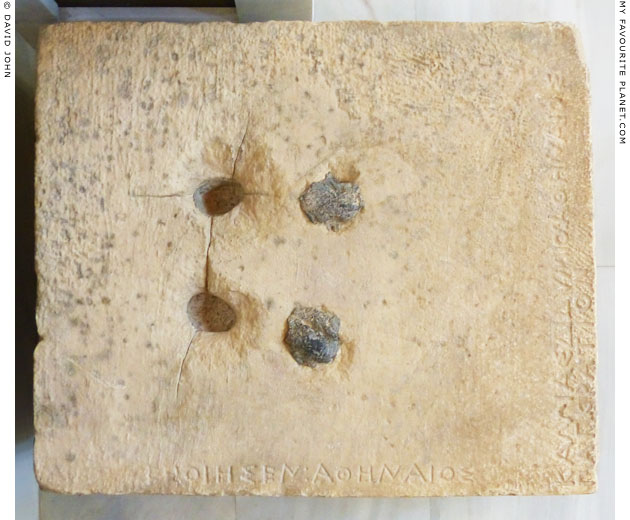
The inscribed top of a marble base for a bronze statue of the Athenian
Kallias, Olympic victor in the pankrationin the 77th Olympiad, 472 BC.
Signed by Mikon of Athens, probably Mikon the Elder of Athens.
After 472 BC. Found on 27th January 1877, east of the northeast corner of the Temple
of Zeus, Olympia. Pentelic marble. Height 31 cm, width 77.5 cm, depth 91.5 cm.
Καλλίας Διδυμίο ∶ Ἀθηναῖος
παγκράτιον.
Μίκων ἐποίησεν ∶ Ἀθηναῖος.
Kallias, son of Didymos, Athenian.
Pankration
Mikon the Athenian made it.
Inscription IvO 146 (also IG I³ 1473)
Olympia Archaeological Museum. Inv. No. Λ 528.
Currently exhibited in the Museum of the History of the Ancient Olympic Games, Olympia. |
| |
Mikon the Younger
Μίκων (Micon Minoris)
Painter
Date unknown, perhaps 5th century BC or Hellenistic period
Pliny the Elder mentioned another painter named Mikon, known as Mikon the Younger, whose daughter was the painter Timarete (Τιμαρέτη).
"Fuit et alius micon, qui minoris cognomine distinguitur, cuius filia timarete et ipsa pinxit."
"There was also another Micon, distinguished from the first Micon by the surname of 'the younger', and whose daughter Timarete also practised the art of painting."
Natural history, Book 35, chapter 35.
Some scholars therefore believe that he must have lived in the 5th century BC or later, but there is no evidence for this.
Pliny mentioned Timarete as the daughter of Mikon again in chapter 40 (see Pliny's list of female painters on the Helena of Egypt page), and wrote that she "painted a Diana [Artemis] at Ephesus, one of the very oldest panel paintings known". If this is true, it begs the question of the painting's age, and the date of the oldest panel paintings known during Pliny's lifetime. The works of Mikon the Elder and Polygnotos of Thasos and other Late Archaic painters are thought to have been painted on wooden panels.
The oldest known Greek panel paintings today are the four "Pitsa Panels" (or "Pitsa Tablets"), dated around 540-510 BC, found in 1934 in a cave near the village of Pitsa (Πιτσά), close to Sikyon, Corinthia. Now in the National Archaeological Museum, Athens, the largest and best preserved is Inv. No. 16464. Although these votive plaques, dedicated to the Nymphs, are beautifully drawn and colourful works, they are simple in style and composition, and probably not comparable to the more sophisticated works later admired by Roman authors. |
|
|
| |
Nikias (of Athens)
Νικίας (Latin Nicias), son of Nikomedes (Νικομήδες)
From Athens, 4th century BC
Pliny the Elder called him Nikias of Athens (Nicias Atheniense), and wrote that he was pupil of Antidotos, who was a pupil of Euphranor of Corinth. He added that the latter two artists were working at the time of the 104th Olympiad (364 BC). He also wrote that he may have been the artist who coloured many of the marble statues of Praxiteles (also placed in the 104th Olympiad), although it could have been an artist of the same name working in the 112th Olympiad (332 BC).
"There was also Antidotus, a pupil of Euphranor, by whom there is, at Athens, a Combatant armed with a shield; a Wrestler, also; and a Trumpeter, a work which has been considered a most exquisite production.
Antidotus, as a painter, was more careful in his works than prolific, and his colouring was of a severe style. His principal glory was his having been the instructor of Nicias of Athens; who was a most careful painter of female portraits, and a strict observer of light and shade [chiaroscuro], making it his especial care that the figures in his pictures should appear in the boldest relief.
His works are, a Nemea, which was brought from Asia to Rome by Silanus, and was placed in the Curia, as already stated [see below]; a Father Liber [Dionysus], in the Temple of Concord; a Hyacinthus, which the Emperor Augustus was so delighted with, that he took it away with him after the capture of Alexandria; for which reason also it was consecrated in the Temple of Augustus [in the Forum, Rome] by the Emperor Tiberius; and a Danaë.
At Ephesus, there is a tomb by him of a Megabyzus, or priest of the Ephesian Diana [the priest of Artemis at Ephesus]; and at Athens a representation of the Necyomantea of Homer [Place of the prophecies of the dead, The Odyssey, Book 4]; which last he declined to sell to King Attalus for sixty talents, and in preference, so rich was he, made a present of it to his own native place.
He also executed some large pictures, among which there are a Calypso, an Io, an Andromeda, a very fine Alexander, in the Porticos of Pompeius, and a Calypso, seated.
To this painter also there are some pictures of cattle attributed, and in his dogs he has been remarkably successful.
It was this Nicias, with reference to whom, Praxiteles, when asked with which of all his works in marble he was the best pleased, made answer, 'Those to which Nicias has set his hand,' so highly did he esteem the colouring of that artist.
It has not been satisfactorily ascertained whether it is this artist or another of the same name that some writers have placed in the hundred and twelfth Olympiad [332 BC].
With Nicias has been compared, and indeed sometimes preferred to him, Athenion of Maronea, a pupil of Glaucion of Corinth. In his colouring he is more sombre than Nicias, and yet, with all his sombreness, more pleasing; so much so indeed, that in his paintings shines forth the extensive knowledge which he possessed of the art."
Pliny the Elder, Natural history, Book 35, chapter 40. At Perseus Digital Library.
The painting of Nemea is thought to have been a personification of the Nemean forest in the northeastern Peloponnese, where Herakles killed the Nemean Lion, the first of his labours.
It seems unlikely that Nikias refused to sell his painting of the Necyomantea of Homer to King Attalus, since the first ruler of this name, Attalus I of Pergamon (269-197 BC, ruled 241-197 BC), lived too late for the dates assumed for the artist's career. It is said that his son Attalus II (ruled 159-139 BC) offered large sums for paintings (see Aristeides of Thebes).
"The late Emperor Augustus did more than all the others; for he placed in the most conspicuous part of his Forum, two pictures, representing War and Triumph. He also placed in the Temple of his father, Caesar, a picture of the Castors [the Dioscuri], and one of Victory, in addition to those which we shall mention in our account of the works of the different artists [chapter 36].
He also inserted two pictures in the wall of the Curia which he consecrated in the Comitium; one of which was a Nemea seated upon a lion, and bearing a palm in her hand. Close to her is an Old Man, standing with a staff, and above his head hangs the picture of a chariot with two horses. Nicias has written upon this picture that he 'inburned' ["inussisse" = encaustic] it, such being the word he has employed."
Natural history, Book 35, chapter 10.
Pliny briefly dicscussed Greek artists who had painted in wax and encaustics, including Praxiteles:
"It is not agreed who was the inventor of the art of painting in wax and in encaustic. Some think that it was a discovery of the painter Aristides, and that it was afterwards brought to perfection by Praxiteles: but there are encaustic paintings in existence, of a somewhat prior date to them, those by Polygnotus, for example, and by Nicanor and Arcesilaüs, natives of Paros. Elasippus too, has inscribed upon a picture of his at Aegina, the word ἐνέχαεν [inburned]; a thing that he certainly could not have done, if the art of encaustic painting had not been then invented."
Natural history, Book 35, chapter 39.
Pliny also wrote that Nikias was the first painter to use "usta", or burnt ceruse, one of the varieties of "minium", red oxide of lead, also known as red lead.
"Usta was accidentally discovered at a fire in the Piraeus, some ceruse having been burnt in the jars there. Nicias, the artist above-mentioned, was the first to use it."
Natural history, Book 35, chapter 39.
According to Pausanias, "Nikias the son of Nikomedes" (Νικίας δὲ ὁ Νικομήδους) made a painting of Hyakinthos (Ὑάκινθος), the youngest and most beautiful son of Lacedaemon and one of Apollo's lovers. This may have been the painting that Pliny said Emperor Augustus took to Rome from Alexandria in Egypt. Pausanias compared the youthful Hyakinthos in Nikias' painting to the sculpture of him as bearded on the monumental "Throne of the Amyklaian", 6 km south of Sparta, designed by the sculptor Bathykles in the mid - late 6th century BC.
"On the altar are also Demeter, the Maid, Pluto, next to them Fates and Seasons, and with them Aphrodite, Athena and Artemis. They are carrying to heaven Hyacinthus and Polyboea, the sister, they say, of Hyacinthus, who died a maid. Now this statue of Hyacinthus represents him as bearded, but Nicias, son of Nicomedes, has painted him in the very prime of youthful beauty, hinting at the love of Apollo for Hyacinthus of which legend tells."
Pausanias, Description of Greece Book 3, chapter 19, section 4. At Perseus Digital Library.
Pausanias also included the painter Nikias the son of Nikomedes in a list of famous people who were buried along the road leading to the Academy at the northwest of Athens.
"Here also are buried Conon and Timotheus, father and son, the second pair thus related to accomplish illustrious deeds, Miltiades and Cimon being the first; Zeno too, the son of Mnaseas and Chrysippus of Soli [Stoic philosophers], Nicias the son of Nicomedes, the best painter from life of all his contemporaries, Harmodius and Aristogeiton, who killed Hipparchus, the son of Peisistratus; there are also two orators, Ephialtes, who was chiefly responsible for the abolition of the privileges of the Areopagus, and Lycurgus, the son of Lycophron."
Pausanias, Description of Greece Book 1, chapter 29, section 15. At Perseus Digital Library.
Paintings of mythological scenes by Nikias' pupil Omphalion (Ὀμφαλίων, otherwise unknown) were noted by Pausanias in the temple of Messene the daughter of Triopas, in Messene (Μεσσήνη), southwestern Peloponnese.
"There is also a temple of Messene the daughter of Triopas with a statue of gold and Parian marble. At the back of the temple are paintings of the kings of Messene: before the coming of the Dorian host to Peloponnese, Aphareus and his sons, after the return of the Heracleidae, Cresphontes the Dorian leader, of the inhabitants of Pylos, Nestor, Thrasymedes and Antilochus, singled out from among the sons of Nestor on the score of age and because they took part in the expedition to Troy.
There is Leucippus brother of Aphareus, Hilaeira and Phoebe, and with them Arsinoe. Asclepius too is represented, being according to the Messenian account a son of Arsinoe, also Machaon and Podaleirius, as they also took part in the affair at Troy. These pictures were painted by Omphalion, pupil of Nicias the son of Nicomedes. Some say that he was also a slave in the house of Nicias and his favourite."
Pausanias, Description of Greece Book 4, chapter 31, sections 11-12). At Perseus Digital Library.
The Roman writer Aelian (Κλαύδιος Αἰλιανός, Claudius Aelianus; circa 175-235 AD) related that Nikias was so absorbed in his work that he neglected his personal health:
"Nicias the Picture-drawer was so intent upon Painting, that he many times forgot to eat, his thoughts being wholly taken up with his employment."
Claudius Aelianus, His Various History, Book 3, Chapter XXXI: Of the diligence of Nicias in his art. Translated by Thomas Stanley. Thomas Dring, London, 1665. At James Eason's website, University of Chicago.
Nikias has also been credited with a painting of Io, Hermes and Argos Panoptes which influenced several other depictions of the subject. |
|
|
| |
Panainos
Πάναινος (Latin, Panaenus)
Athens, mid 5th century BC
A close colleague and relative of Pheidias, perhaps his nephew (Strabo, Book 8, chapter 3, section 30) or brother (Pliny the Elder, Book 35, chapters 34 and 35, Book 36, chapter 55; Pausanias, Book 5, chapter 11, sections 5-6), although the name may refer to two painters from the same family.
Panainos worked with the painters Polygnotos of Thasos and Mikon in Athens. The painting of the Battle of Marathon (490 BC) in the Stoa Poikile (painted portico) of the Athenian Agora was attributed to him (Pausanias, Book 5, chapter 11, section 6; Pliny, Book 35, chapter 35, see below) and to Polygnotos, who may have assisted him, and also to Mikon.
See: Vin Massaro, Herodotos' account of the Battle of Marathon and the picture in the Stoa Poikile, in L'Antiquité Classique, Tome 47, fasc. 2, 1978, pages 458-475. Brussels, 1978. At Persée.
He painted Pheidias' colossal chryselephantine statue of Zeus in the Temple of Zeus at Olympia (around 432 BC), particularly the god's garment, as well "many wonderful paintings" around the temple (Strabo, Geography, Book 8, chapter 3, section 30).
Pausanias wrote that Panainos painted mythological scenes on the screens around the throne of the Zeus statue at Olympia:
"The throne is supported not only by the feet, but also by an equal number of pillars standing between the feet. It is impossible to go under the throne, in the way we enter the inner part of the throne at Amyclae. At Olympia there are screens constructed like walls which keep people out.
Of these screens the part opposite the doors is only covered with dark-blue paint; the other parts show pictures by Panaenus. Among them is Atlas, supporting heaven and earth, by whose side stands Heracles ready to receive the load of Atlas, along with Theseus; Perithous, Hellas, and Salamis carrying in her hand the ornament made for the top of a ship's bows; then Heracles' exploit against the Nemean lion, the outrage committed by Ajax on Cassandra, Hippodameia the daughter of Oenomaus with her mother, and Prometheus still held by his chains, though Heracles has been raised up to him. For among the stories told about Heracles is one that he killed the eagle which tormented Prometheus in the Caucasus, and set free Prometheus himself from his chains.
Last in the picture come Penthesileia giving up the ghost and Achilles supporting her; two Hesperides are carrying the apples, the keeping of which, legend says, had been entrusted to them. This Panaenus was a brother of Pheidias; he also painted the picture of the battle of Marathon in the painted portico at Athens."
Pausanias, Description of Greece, Book 5, chapter 11, sections 4-6. At Perseus Digital Library.
Pliny the Elder believed Panainos to be the brother of Pheidias, and placed him among the most eminent Greek painters. He mentioned Panainos' painting of the shield of a statue of Athena and his decoration of the walls of the temple of Athena at Elis, western Peloponnese.
"Seeing that Phidias himself is said to have been originally a painter, and that there was a shield at Athens which had been painted by him: in addition to which, it is universally agreed that in the eighty-third Olympiad [448 BC], his brother Panaenus painted, at Elis, the interior of the shield of Minerva [Athena], which had been executed by Colotes, a disciple of Phidias and his assistant in the statue of the Olympian Jupiter [Zeus]."
Pliny the Elder Natural history, Book 35, chapter 34. At Perseus Digital Library.
"At Elis, there is a Temple of Minerva [Athena], which was pargetted [decorated with a layer of plaster or mortar], they say, by Panaenus, the brother of Phidias, with a mortar that was blended with milk and saffron: hence it is, that, even at the present day, when rubbed with spittle on the finger, it yields the smell and flavour of saffron."
Natural history, Book 36, chapter 55. At Perseus Digital Library.
Pliny noted a painting of the Battle of Marathon by Panainos, and reported that Panainos was unsuccessful in the painting competition of the Pythian festival at Delphi.
"Panaenus, too, the brother of Phidias, even executed a painting of the battle fought by the Athenians with the Persians at Marathon: so common, indeed, had the employment of colours become, and to such a state of perfection had the art arrived, that he was able to represent, it is said, the portraits of the various generals who commanded at that battle, Miltiades, Callimachus, and Cynægirus, on the side of the Athenians, and, on that of the barbarians, Datis and Artaphernes."
Natural history, Book 35, chapter 34.
"And not only this, but, during the time that Panaenus flourished, there were contests in the pictorial art instituted at Corinth and Delphi. On the first occasion, Panaenus himself entered the lists, at the Pythian Games [at Delphi], with Timagoras of Chalcis, by whom he was defeated; a circumstance which is recorded in some ancient lines by Timagoras himself, and an undoubted proof that the chroniclers are in error as to the date of the origin of painting."
Natural history, Book 35, chapter 35.
The painting of the Battle of Marathon described by Pausanias as hanging in the Stoa Poikile (painted portico) of the Athenian Agora is thought to be the same as the work mentioned by Pliny.
"At the end of the painting are those who fought at Marathon; the Boeotians of Plataea and the Attic contingent are coming to blows with the foreigners. In this place neither side has the better, but the center of the fighting shows the foreigners in flight and pushing one another into the morass, while at the end of the painting are the Phoenician ships, and the Greeks killing the foreigners who are scrambling into them. Here is also a portrait of the hero Marathon, after whom the plain is named, of Theseus represented as coming up from the under-world, of Athena and of Heracles. The Marathonians, according to their own account, were the first to regard Heracles as a god. Of the fighters the most conspicuous figures in the painting are Callimachus, who had been elected commander-in-chief by the Athenians, Miltiades, one of the generals, and a hero called Echetlus, of whom I shall make mention later."
Pausanias, Description of Greece, Book 1, chapter 15, section 3. At Perseus Digital Library.
Although he did not name the artist here, as we have seen in the quote above, he attributed the Marathon painting to Panainos when discussing the statue of Zeus at Olympia. |
|
|
| |
Philoxenos of Eretria
Φιλόξενος (Latin, Philoxenus)
From Eretria, Euboea, late 4th century BC
A pupil of Nikomachos, father and teacher of Aristeides of Thebes (Pliny the Elder, The Natural History, Book 35, chapter 36)
"Philoxenus of Eretria, who painted for King Cassander a picture representing one of the battles between Alexander and Darius, a work which may bear comparison with any.
He also painted a picture in grotesque, representing Three Sileni at their revels. Imitating the celerity of execution displayed by his master, he introduced a more sketchy style of painting, executed in a comparatively off-hand manner."
Pliny the Elder, Natural history, Book 35, chapter 36.
Philoxenos' battle between Alexander the Great and King Darius III of Persia (probably painted after 315 BC) is one of three paintings modern scholars think may have been the model for the "Alexander Mosaic".
See also:
Aristeides of Thebes and Helena of Egypt. |
|
|
| |
Protogenes
Πρωτογένης (Protogenes of Caunus)
4th century BC
Pliny the Elder and Plutarch wrote that he was from Kaunos (Καῦνος), between Caria and Lycia, southwestern Anatolia, and later lived in Rhodes. According to the Suidas (pi, 2963 at Suda On Line) he was from Xanthos (Ξάνθος), Lycia. Both cities were under the control of Rhodes as part of the Rhodian Peraia, although from the late 4th century BC, following the Persian occupation, the area was fought over by the successors (Diadochi) of Alexander the Great.
The Suidas also states that he wrote two books: On Graphic Art (Περὶ γραφικῆς) and Figures (σχηματων βιβλία β᾽).
Works by Protogenes and episodes of his life were mentioned by a number of ancient authors, including Aulus Gellius, Cicero, Petronius, Plutarch, Quintilian, Strabo and Pliny the Elder, who dedicated long passages to him in his Natural history (Book 35, chapter 36).
Pliny described him as "a famous painter", and relates that he was an impoverished "ship-decorator" (or painter of ships) until he was fifty. He also wrote of his friendly competition with Apelles, who considered him "fully his equal, or perhaps his superior", and who championed his works in Rhodes, and mentioned that he made bronze statues, listing him among the artists who "made statues of athletes, armed men, hunters, and sacrificers" (Book 34, chapter 19).
Protogenes is reported to have been a fussy and capricious perfectionist who took a long time to complete his works which, according to Pliny "bore evident marks of unbounded laboriousness and the most minute finish". He did not know "when to take his hand off a picture". Pliny referred to his quest for perfection in his art when he was painting his most famous work depicting the mythical Rhodian hero Ialysos (Ἰάλυσος), which took seven years to complete, and which he painted over four times, "so that when an upper coat might fail, there would be an under one to succeed it". Frustrated that the foam on the mouth of the hero's dog was not realistic enough, he tried to erase it with a sponge, and thus accidentally achieved the effect he been trying to get with a brush and invented a new technique, later used by the painter Nealces.
The beauty, realism, accuracy and perfection of his paintings were also noted by Cicero (Brutus, section 70, see Aetion; Orator, chapter 2, section 5), Petronius Arbiter (Satyricon, section 83, see quote above) and Quintilian (Institutio Oratoria, Book 12, chapter 10).
The Ialysos painting was the subject of an anecdote with several versions, concerning the siege of Rhodes by Demetrios Poliorketes (Δημήτριος Πολιορκητής, the Besieger) in 305 BC (Pliny, Book 35, chapter 36; Plutarch, Demetrius, chapter 22, section 2). The Macedonian general was said to have been so impressed with Protogenes and his work that he spared the painting, which according to Pliny was in the only part of the city vulnerable to attack. In Pliny's version Protogenes lived in a suburb outside the city walls, which became the centre of Demetrius' camp, where the artist continued to work untroubled by the warfare. The besieger gave him a guard and often visited him in his studio. In the version related by Aulus Gellius (Attic Nights, Book 15, chapter 31), Protogenes was already dead by the time Rhodian envoys asked Demetrius to spare the painting.
Cicero (Orator, chapter 2, section 5) reported seeing the Ialysos in Rhodes (around 77 BC), and Strabo (Geography, around 20 BC - 23 AD, Book 14, chapter 2, section 5) also records the painting as being there. But by the time of Pliny (Natural history, published 77-79 AD, Book 35, chapter 36) it had been taken to Rome and placed among many other artworks in the Temple of Peace (Templum Pacis), which Plutarch (circa 46-120 AD) claimed was destroyed by a fire: "This painting, then, crowded into the same place with the rest at Rome, the fire destroyed." (Plutarch, Demetrius, chapter 22, section 2)
Another work Pliny said was destroyed by fire in Rome was the result of a playful contest between Protogenes and Apelles, who visited him in Rhodes. It consisted of a panel with three exquisitely fine lines, two painted by Apelles and the other by Protogenes. The work was very popular among Roman art-lovers, perhaps as much for the story behind it as for is delicacy.
"He [Protogenes] thought proper, too, to transmit the panel to posterity, just as it was, and it always continued to be held in the highest admiration by all, artists in particular. I am told that it was burnt in the first fire which took place at Caesar's palace on the Palatine Hill; but in former times I have often stopped to admire it. Upon its vast surface it contained nothing whatever except the three outlines, so remarkably fine as to escape the sight: among the most elaborate works of numerous other artists it had all the appearance of a blank space; and yet by that very fact it attracted the notice of everyone, and was held in higher estimation than any other painting there."
Other works listed by Pliny (all Natural History, Book 35, chapter 36):
Displayed in the Propylaia of the Athens Acropolis, probably in the "Pinakotheke": "where he has painted the fine picture of Paralus and Hammonias, known by some as the Nausicaa, he has added in the side pieces of the picture, by painters called 'parerga', several small ships of war; wishing thereby to show in what department that skill had first manifested itself which had thus reached the citadel of Athens, the scene of his glory."
This is thought to have been an allegorical painting representing two of the sacred Athenian state ships, but was later somehow mistakenly believed to represent Odysseus and Nausicaa, a subject taken from Homer's Odyssey.
"Protogenes executed also, a Cydippe; a Tlepolemus; a portrait of Philiscus, the tragic poet, in an attitude of meditation; an Athlete; a portrait of King Antigonus [father of Demetrios Poliorketes], and one of the mother of Aristotle. It was this philosopher too, who advised him to paint the exploits of Alexander the Great, as being certain to be held in everlasting remembrance. The impulse, however, of his natural disposition, combined with a certain artistic caprice, led him in preference to adopt the various subjects which have just been mentioned. His last works were representations of Alexander and the god Pan. He also executed some figures in bronze, as already stated."
Pliny also mentioned a painting of a Satyr holding a pair of pipes, known as the "Anapauomenos" (ἀναπαυόμενος, he that rests, or in repose). Strabo (Geography, Book 14, chapter 2, section 5) wrote that in Rhodes there was a painting by Protogenes depicting a Satyr standing by a pillar on top of which stood a male partridge. The public considered the partridge so realistic that it caused a sensation. The painter was not all happy about the scenes caused and the feared that his Satyr was being ignored, so he simply erased the bird:
"And at this partridge, as would be natural, the people were so agape when the picture had only recently been set up, that they would behold him with wonder but overlook the Satyr, although the latter was a very great success. But the partridge-breeders were still more amazed, bringing their tame partridges and placing them opposite the painted partridge; for their partridges would make their call to the painting and attract a mob of people. But when Protogenes saw that the main part of the work had become subordinate, he begged those who were in charge of the sacred precinct to permit him to go there and efface the partridge, and so he did."
In an anecdote related by the Roman writer Aelian (Κλαύδιος Αἰλιανός, Claudius Aelianus; circa 175-235 AD), Protogenes' perfectionism, his painting of Ialysos and his relationship with Apelles are all brought neatly together in one short passage:
"Protogenes the Painter, as is said, bestowed seven years in drawing Ialysus, at last perfected the Piece: which Apelles seeing, at first stood mute, struck with admiration of the wonderful sight; then looking off from it, said, 'Great is the work and the workman; but the grace is not equal to the pains bestowed upon it; which if this man could have given it, the work would have reached to Heaven.'"
Claudius Aelianus, His Various History, Book 12, Chapter XLI: Of Protogenes the Painter. Translated by Thomas Stanley. Thomas Dring, London, 1665. At James Eason's website, University of Chicago. |
|
|
| |
Pythagoras of Paros
Πυθαγόρας
From Paros
Pausanias mentioned that Pythagoras of Paros made a painting of the Graces (Χάριτες, Charites), draped rather than naked, which was displayed at Delphi.
"And near what is called the Pythium there is a portrait of Graces, painted by Pythagoras the Parian."
Pausanias, Description of Greece, Book 9, chapter 35, section 7. At Perseus Digital Library.
(Chapter 35 consists entirely of a discussion on the history of the worship and depiction of the Graces. See also Apelles.) |
|
|
|
| |
Turpilius
A Roman painter from a noble Venetian family. The first recorded left-handed painter.
Early Imperial period, 1st century AD
"After this period [2nd century BC], the art [of painting] was no longer practised by men of rank; unless, indeed, we would make reference to Turpilius, in our own times, a native of Venetia, and of equestrian rank, several of whose beautiful works are still in existence at Verona. He painted, too, with his left hand, a thing never known to have been done by any one before."
Pliny the Elder, Natural History, Book 35, chapter 7. At Perseus Digital Library. |
|
|
| |
Zeuxis
Ζεῦξις (abbreviation of Ζεύξιππος, Zeuxippos)
5th century BC; born in 464 BC
He was from Heraklea (Ἡράκλεια), although which of the many cities with this name is unknown. Suggestions that he was from Heraclea Lucania in southeast Italy seem unlikely, as this city was only founded in 432 BC.
One of the most famous ancient Greek painters who also made small ceramic figures (figlina opera).
He was commissioned by Archelaos I of Macedon (ruled 413-399 BC) to decorate the royal palace at the new Macedonian capital Pella. |
|
|
| |
|
|
| |
| |
 |
| |
 |
| |
 |
| |
 |
| |
 |
| |
 |
| |
George Alvanos
rooms in
Kavala's historic Panagia District
Anthemiou 35,
Kavala, Greece
kavalarooms.gr
|
| |
Olive Garden Restaurant
Kastellorizo,
Greece
+30 22460 49 109
kastellorizo.de
|
| |
Papoutsis
Travel Agency
Kastellorizo,
Greece
+30 22460 49 286
greeklodgings.gr
|
| |
|











